![]()
![]()
![]()
Use LEFT and RIGHT arrow keys to navigate between flashcards;
Use UP and DOWN arrow keys to flip the card;
H to show hint;
A reads text to speech;
105 Cards in this Set
- Front
- Back
|
What is a chromatin |
Is the complex of DNA and protein housed in the nucleus that is formed from the chromosomes what does the |
|
|
What does the nuclear envelope have |
Nuclear envelope has pote structures that regulate what may enter or leave the nucleus. |
|
|
What is the nucleolus |
A region of the nucleus where ribosomal RNA Is synthesized and complexes with proteins to form ribosomal subunits. |
|
|
What are desmosomes |
Fastened adjacent animal cells together, functioning like rivers to fasten cells into strong sheets |
|
|
what are Gap junctions |
Provide channels between adjacent animal cells through which ions, sugars, communication molecules and other small molecules can pass |
|
|
Which molecule can’t can’t easily enter the cell? Which molecule Can and why? |
1. Hydrophilic molecules can’t enter the cell easily 2. Hydrophobic molecules Can because of the selective permeable plasma membrane. |
|
|
The protein that are embedded in the membrane what do they do. |
They serve as transport channels to move materials across the hydrophobic interior to bind to signaling molecules (ligands) |
|
|
What is a peripheral protein and what is an example of a loose protein |
1. They are protein loosely bound to the membrane’s surface. 2. G protein is a loose protein |
|
|
How can a G protein move along the membrane |
It can move across the membrane if a ligand binds with a G protein- coupled receptor |
|
|
What can nonpolar molecules do |
The molecule is hydrophobic this it can dissolve in the hydrophobic interior in the phospholipid bilayer and cross the membrane easily |
|
|
How to hydrophilic pass through |
Hydrophilic substances can avoid the lipid bilayer by passing through transport proteins than span the membrane |
|
|
What does water move through |
Water moves through special transport proteins called aquaporin |
|
|
Which hydrophobic substances can pass easily across the membrane by passive diffusion |
Hydrocarbons , Carbon Dioxide, and Oxygen Can pass through passive diffusion |
|
|
What is the diffusion of water moved across a selectively permeable membrane |
Ósmosis is the diffusion of water across a selectively permeable membrane |
|
|
Describe a isotonic solution |
1. There is no net movement of water across the plasma membrane 2. Water crossed the membrane at the same rate in both directions |
|
|
What describe a hypertonic solution |
A cell will lose water to it’s surrounds. There is more solutes in the water around the cell. In this case the cell loses water to the environment, shrivels, May die |
|
|
Describe a hypotonic solution |
Water will enter the cell faster than it leaves. Fewer diluted in the water around the cell. The solutes are more heavily concentrated which causes the cell to swell and may burst. |
|
|
Where does water move from |
Water moves from a hypotonic solution to a hypertonic solution. |
|
|
What is facilitated diffusion |
The process by which ions and hydrophilic substances diffuse across the cell membrane with the help of transport proteins |
|
|
What are the two ways facilitated diffusion transports ions and hydrophilic substances |
1. They provide a hydrophilic channel through which the molecules can pass 2. They bind loosely to the molecules and carry them through the membrane |
|
|
Describe active transport |
Active transport substances are moved against their concentration gradient. That is from lower concentration to higher concentration. This transport requires ATP energy |
|
|
What is an example of active transport? And what is the example necessary for. |
1. An example of active transport is sodium potassium pump 2. It is necessary for proper nerve transmission. |
|
|
What is a chemical force |
The Jon’s concentration gradient |
|
|
What is voltage gradient |
Across the membrane attract positively charged ions and repels negatively charged ions |
|
|
What two forces drive the diffusion of ions across the membrane |
Because of membrane potential the inside of the cell that is negatively charged and the positively charged ions on the outside such as sodium are attracted to the negative charges inside the cell. Which drives the two forces |
|
|
What is membrane potential |
It is the difference in electric charge across a membrane that is expressed in voltage |
|
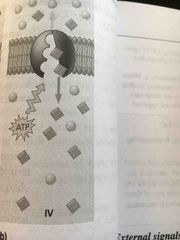
Front (Term) |
Represents ATP and molecules being moved against a concentration gradient |
|
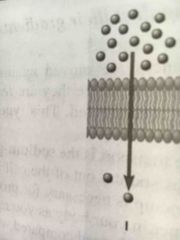
Front (Term) |
Figure 1 represents simple diffusion |
|
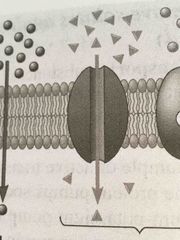
Front (Term) |
Figure 2 represents facilitated diffusion with a channel protein |
|
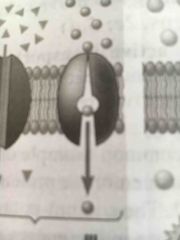
Front (Term) |
Figure 3 represents facilitated diffusion with a carrier protein |
|
|
Predict the effect of additional triangle shaped molecules to the lower portion of Diagram A would have on the net movement of molecules through figure 2 |
The net movement of molecules through figure 2 would stop when there are more molecules in the lower compartment as molecules move from a region of high concentration to a region of lower concentration Of |
|
|
Describe exocytosis |
Vesicles from the cell’s interior dude with the cell membrane expelling their contents |
|
|
Describe Endocytosis |
The cell forms new vesicles from the plasma membrane. This process allows the cell to take in macromolecules |
|
|
What is an example of endocytosis |
Engulfing of foreign particles by white blood cells or amoebas. |
|
|
What is reception |
The target cell’s detection of a signal molecule coming from outside the cell |
|
|
What is transduction |
The conversion of the signal to a form that can bring about a specific cellular response |
|
|
What is response |
The specific cellular response to the signal molecule |
|
|
Where are intracellular receptors at |
Are found inside the plasma membrane in the cytoplasm or nucleus the signal molecule must cross the plasma and therefore must be hydrophobic like the steroid hormone testosterone. |
|
|
What do plasma membrane receptor do |
Bind to water- soluble ligands |
|
|
What is a G-coupled receptor |
A membrane receptor that works with the help of a G protein |
|
|
What are receptor tyrosine kinases |
Are a second type of membrane protein |
|
|
What do specific signal molecules cause |
They cause ligand-gated ion channels in a membrane to open or close, regulating the flow of specific ions. |
|
|
What is a protein phosphatases |
Are enzymes that remove phosphate groups and inactivate proteins that were activated by kinases |
|
|
What is the signal turned off by and what is the signal turned on by |
1. The signal is turned on by kinases 2. Turned off by phosphatases |
|
|
What are the two common second messengers |
1. Calcium ions are second messengers 2. Cyclic AMP is another common second messengers |
|
|
What happens during apoptosis |
The cell is systematically dismantled and digested ( This protects neighboring cells from damage) |
|
|
What is apoptosis essential for |
A normal nervous system, for the operation of the immune system, and for normal morphogenetic of hands and feet in humans |
|
|
What is the cell cycle |
Is the life of a cell from the time it is formed from a dividing parent cell until it’s own division into two cells |
|
|
What must be copied before a cell can divide |
The cell’s genome needs to be copied |
|
|
How many chromosomes does a human somatic cell have? |
46 chromosomes |
|
|
What is the process of mitosis |
Somatic cell’s divide, forming daughter cells that contain the same chromosome number as the parent cell |
|
|
What are human gametes |
Sperm and egg cells are haploid and have half the number of chromosomes as a diploid cell |
|
|
How many chromosomes do human gametes have |
Human gametes have 23 chromosomes |
|
|
What is meiosis |
A special type of cell division that results in gametes |
|
|
What does each duplicated chromosome contain |
They consist two sister chromatically attaches by te centromere |
|
|
What is mitosis |
Is the division of the cell’s nucleus |
|
|
What is cytokinesis |
The division of the cell’s cytoplasm |
|
|
What are the primary events of Interphase |
1. G1 phase: the cell grows while carrying out cell functions unique to its cell type 2. S phase: the cell continues to carry out to its unique functions it also duplicates its chromosomes. 3. G2 phase: is the period after the chromosomes have been duplicated and just before mitosis. The cell continues to grow and carry out its functions during this time. |
|
|
What happens during prophase |
1. Chromosomes become more tightly coiled into discreet chromosomes 2. Nucleoli disappear 3. The mitotic spindle ( consisting of microtubules extending from the two centrosomes) begins to form in the cytoplasm |
|
|
What happens during prometaphase |
1. The nuclear envelope begins to fragment allowing the microtubules to attach to the chromosomes 2. The two chromatids of each chromosome are held together by the centromere. The centromere contains protein kinetochores on each chromatid where the microtubules attach |
|
|
What happens in Metaphase |
1. The microtubules move the chromosomes to the metaphase plate at the equator of the cell. The microtubule complex is referred to as the spindle 2. The centrioles have migrated to opposite poles in the cell riding along on the developing spindle |
|
|
What happens during anaphase |
1. Sister chromatids begin to separate pulled apart by motor molecules interacting with kinetochore microtubules and the cell elongates 2. By the end of anaphase the opposite ends of the cell both contain complete and equal sets of chromosomes. |
|
|
What happens during telophase |
1. The nuclear envelopes reform around the sets of chromosomes locate at opposite ends of the cell 2. The chromatin fiber of the chromosomes becomes less condensed |
|
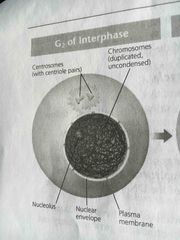
Front (Term) |
Model of G2 interphase |
|
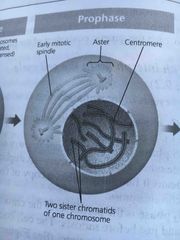
Front (Term) |
Model of prophase |
|
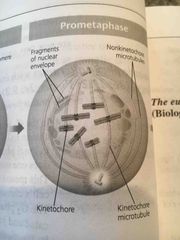
Front (Term) |
Model of prometaphase |
|
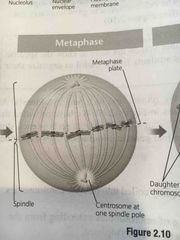
Front (Term) |
Diagram of metaphase |
|
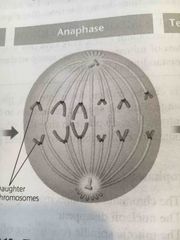
Front (Term) |
Diagram of anaphase |
|
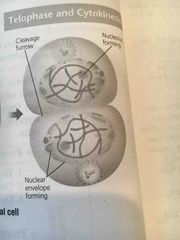
Front (Term) |
Diagram of telophase and cytokinesis |
|
|
What happens during Cytokinesis |
Begins during which the cytoplasm if the cell is divided. In animal cells, a cleave furrow forms that eventually divides the cytoplasm in plant cells. A cell plate forms that divides the cytoplasm |
|
|
How do prokaryotes replicate their genome |
They replicate their genome by binary fission |
|
|
What is the G0 phase |
It is a non dividing phase for cells that didn’t get the go ahead signal either one of the checkpoints |
|
|
What is kinases |
Enzymes that control the cell cycle |
|
|
How does the cell stop cell division |
During anaphase MPF switches itself off by starting a process that leads to the destruction of cyclin molecules. |
|
|
Front (Term) |
Step2: The G protein binds to a specific enzyme and activated it when the enzyme is activated, it can trigger the next step in a pathway leading to a cellular response. All the molecular shape changes are temporary to continue the cellular response new signal molecules are required |
|
|
Front (Term) |
Back (Definition) |
|
|
Front (Term) |
Back (Definition) |
|
|
Front (Term) |
Back (Definition) |
|
|
Front (Term) |
Back (Definition) |
|
|
Front (Term) |
Back (Definition) |
|
|
What is density dependent inhibition |
The phenomenon in which crowded cells stop dividing |
|
|
What is Anchorage dependency |
In which normal cells must be attached to a substratum such as the extracellular matrix of tissue to divide |
|
|
What is transformation |
The process that converts a normal cell to a cancer cell |
|
|
When do you call a tumor benign |
When the abnormal cells remain at the original site |
|
|
What is a tumor |
A mass of abnormal cells within otherwise normal tissue |
|
|
What is a malignant tumor |
Becomes invasive enough to impair the functions of one or more organs |
|
|
How do you activate a G protein |
When a ligand bind to a G-protein-coupled receptor it causes a change to be able to bind to a inactive G protein causing GTP to displace GDP. This activated the G protein |
|
|
What are three examples of chemical signaling pathways |
1. G-protein-coupled receptor 2. Ligand-gated Ion channels 3. Receptor tyrosine kinases |
|
|
Front (Term) |
Step 1: the ligand or signaling molecule has bound to the G-protein-coupled receptor. This cause a conformational change in the receptor so that it may now bind to an inactive G protein causing a GTP to displace GDP this activated the G protein |
|
|
How does the cell stop cell division |
During anaphase MPF switches itself off by starting a process that leads to the destruction of cyclin molecules. |
|
|
Front (Term) |
Step2: The G protein binds to a specific enzyme and activated it when the enzyme is activated, it can trigger the next step in a pathway leading to a cellular response. All the molecular shape changes are temporary to continue the cellular response new signal molecules are required |
|
|
Front (Term) |
Back (Definition) |
|
|
Front (Term) |
Back (Definition) |
|
|
Front (Term) |
Back (Definition) |
|
|
Front (Term) |
Back (Definition) |
|
|
Front (Term) |
Back (Definition) |
|
|
What is density dependent inhibition |
The phenomenon in which crowded cells stop dividing |
|
|
What is Anchorage dependency |
In which normal cells must be attached to a substratum such as the extracellular matrix of tissue to divide |
|
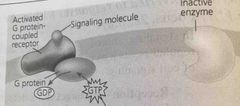
Front (Term) |
Step 1: the ligand or signaling molecule has bound to the G-protein-coupled receptor. This cause a conformational change in the receptor so that it may now bind to an inactive G protein causing a GTP to displace GDP this activated the G protein |
|
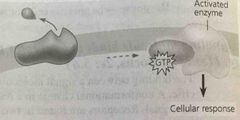
Front (Term) |
Step2: The G protein binds to a specific enzyme and activated it when the enzyme is activated, it can trigger the next step in a pathway leading to a cellular response. All the molecular shape changes are temporary to continue the cellular response new signal molecules are required |
|

Front (Term) |

Back (Definition) |
|
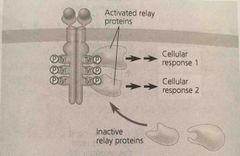
Front (Term) |

Back (Definition) |
|
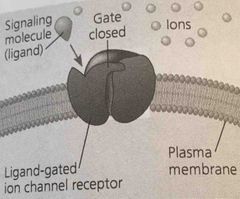
Front (Term) |
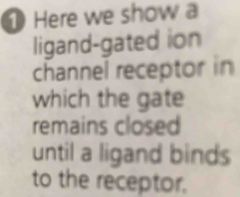
Back (Definition) |
|
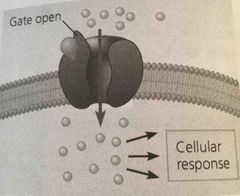
Front (Term) |
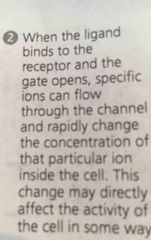
Back (Definition) |
|
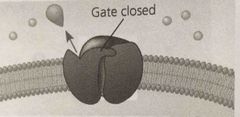
Front (Term) |
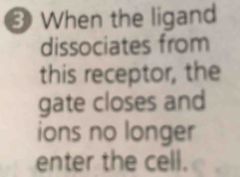
Back (Definition) |

